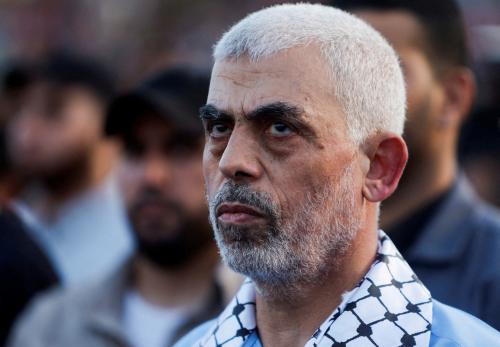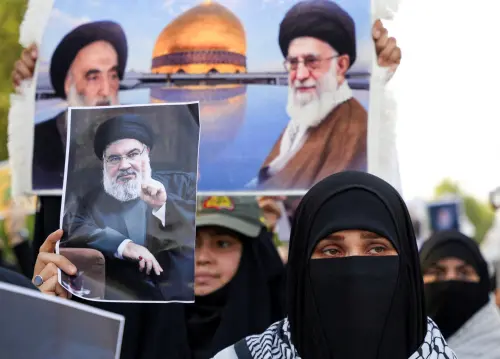Editor’s note: Israelis will go to the polls on March 17 to elect the 20th Knesset, Israel’s parliament, which will then form a new government to replace Prime Minister Benjamin Netanyahu’s current one[1] (he hopes to head the next government as well.) We are following the run-up to the elections in a series here on Markaz, the blog of the Brookings Center for Middle East Policy.
This week, Israel’s Labor Party, the main opposition party to Prime Minister Benjamin Netanyahu, held primaries and elected its slate of candidates. That slate, headed by Labor Chairman Isaac Herzog, will be combined with Tzipi Livni’s party Hatnua, in an electoral alliance, now officially called “The Zionist Camp.”
The Zionist Camp is currently polling just ahead of Netanyahu’s Likud as the largest faction in the next Knesset, with a chance to form the next government. However, the alliance still faces a formidable challenge, leaving Netanyahu ahead nonetheless.
Since 1977, the year the right-wing Likud party broke Labor’s stronghold on Israeli politics, the Likud — now led by Prime Minister Benjamin Netanyahu — has dominated Israel’s leadership. In the 38 years since, Likud prime ministers have led the country for 27, while Labor prime ministers have held office for only 8 years (Ehud Olmert, a former Likudnik who headed the centrist Kadima — primarily an offshoot of the Likud — led the country for three more.)
For nearly four decades, then, Israel’s leadership has been the right-wing’s to lose. When Labor did win, its victory included four key elements:
1. The incumbent right-wing must be in trouble in its own right.
As I noted here, in democracies incumbents lose more than challengers win.
In 1984, after seven years of Likud governments, the Israeli economy was crippled by annual inflation of nearly 445 percent and the country was mired in a bloody war in Lebanon. The public had naturally soured on the incumbent party, which allowed Shimon Peres and Labor to come to a draw with the Likud and to subsequently share power in a national unity government, which Peres led for the first two years.
Similarly, in 1992, the Likud appeared to most Israelis as an old, corrupt party that had lost its way, becoming mired in intra-party fights and scandal. This allowed Yitzhak Rabin to capitalize on the Likud’s weakness and return to the prime minister’s office after a 15 year hiatus (he first served in the post in the 1970s).
In 1999, Ehud Barak’s victory owed a lot to widespread disappointment with the young, brash and inexperienced prime minister who preceded him — Netanyahu, in his first term.
Today again, there is Netanyahu fatigue, though his image has improved dramatically from the 1990s. After a combined 9 years as prime minister, second only to David Ben-Gurion, Netanyahu is held largely responsible for Israel’s mixed fortunes. In a recent poll by the Israel Democracy Institute, a full 60 percent of the public disapproved of the way “The Government is handling the country’s problems”. Even among self-defined right-wing voters, 56 percent disapproved of the government’s performance, though this number likely overstates the case somewhat.[2]
Not surprisingly, then, a clear majority (60 percent) of Israelis polled in early December said they preferred that Netanyahu not lead the next government, providing an opening for Herzog, Livni and the Zionist Camp.
2. The left must shift and sharpen the debate to economic issues, where it has an advantage in public opinion.
The instincts of the Israeli public on economic issues, the popular (and at times populist) position leans decidedly to the left. Whereas American voters are often referred to, by default, as taxpayers, and vows to refrain from tax hikes are a staple of contemporary American politics, In Israel, much of the voting public prefers a more robust welfare state and has much higher tolerance for deficits and taxes on the wealthy.
This tendency was most apparent in the dramatic events of the summer of 2011. Then, hundreds of thousands of people — in a country of eight million — took to the streets, in a series of demonstrations over several weeks and in tent encampments, chanting most famously: “The people demand social justice!” In relative terms, the demonstrations dwarfed similar phenomena in other countries, like the “Occupy Wall Street” movement, and, moreover, they garnered mainstream support far beyond their numbers; the demonstrations were peaceful, remarkably disciplined even while led by largely unknown and very young leaders. The country, the frightened government, and demonstrators themselves were taken utterly by surprise at the wave of protest that swept the country.
Where the demonstrations were weakest was in a clear, unified message, and as will be discussed in a future post, their electoral dividend was dispersed among several parties, most notably the centrist (and upper middle class) Yesh Atid, the party of Yair Lapid, the current finance minister.
And yet, the most remarkable outcome of Labor’s primaries was the success of two of the protests most notable leaders, Stav Shaffir and Itzik Shmuli. In the last Knesset, to which they were both elected, they both stood out as hard-working, disciplined and skilled parliamentarians, despite their youth. Shaffir, in particular, has become known for her vocal and uncompromising battle against backroom deals and hushed transfers of state funds in the finance committee, of which she is a member. Although still in her twenties — one of the youngest Knesset members ever — she has, backed by an army of volunteers, outperformed many of her seniors in the Knesset.
Via Livni’s party, the Zionist Camp will also include Manuel Trajtenberg, a famous economist who led a governmental committee tasked with addressing the concerns of the social protests. He will ostensibly be the party’s candidate for finance minister. The list also includes another (far more leftist) economist, Yossi Yonah, who had advised the protestors and was a fierce critic of Trajtenberg’s committee, which he saw as a fig leaf for the government’s policies.
While Labor’s competition from centrist parties for the domestic agenda is fierce, it has successfully positioned itself as the voice of a left-leaning economic agenda. Among young middle class voters, in particular, this appears to be paying off (a recent poll shows the Zionist Camp as the leading party among Israeli college students, who also cite social-economic issues as their top concern).
From Labor and the combined Zionist Camp’s perspective, the more salient the economic debate and the clearer the differences between the sides, the better they hope to fair in the elections.
3. The left must present a credible, centrist, alternative on national security issues, where it is electorally weaker.
A shift to a domestic agenda would help Labor considerably, but Israeli politics are still defined, fundamentally, along a hawk-to-dove axis. Since 1967, “right-wing” in Israel means, in fact, hawkish on Arab-Israeli relations, while “left-wing” tends to mean dovish.
In recent years, the “left” brand has been deeply unpopular. Gravely wounded by the Second Intifada, which to many Israelis seemed to disprove a Palestinian desire for peace, leftist views have come to be seen as naïve, even reckless, on security. This was a central consideration for Herzog in aligning with Livni, a former Likudnik herself, who gives the joint list a more centrist veneer.
To counter this weakness, even before Oslo, Labor has relied on candidates with strong security credentials. Yitzhak Rabin was a general, chief of staff of the IDF during the 1967 war, and a former hawkish defense minister. Ehud Barak was similarly a former IDF chief of staff and a famed commando officer.
Herzog‘s father, a former president of Israel was a general (chief of military intelligence), and his brother is a brigadier general (in the reserves) and now a well-known analyst of Israeli affairs. But Isaac Herzog is known primarily as a lawyer and politician. In demeanor and experience he brings no security credentials to the campaign. The Labor slate, moreover, includes only one notable former officer, Omer Bar Lev, a colonel who was a notable commando officer and also the son of a former IDF chief of staff (and Labor minister), Haim Bar Lev.
Not coincidentally, Netanyahu’s camp has gone on the attack; the Yisrael Hayom publication, funded by Netanyahu’s main U.S. donor Sheldon Adelson (and known to many as the “Bibipaper” the Bibiton), reacted to the primaries by calling the slate “leftist”.
Herzog will likely try to remedy this situation with the extra-primary appointment of a former military figure to the list, quite possibly Shaul Mofaz, the former defense minister from the Likud and Kadima, or Amos Yadlin, currently the Director of the Institute for National Security Studies in Israel and another son of a Labor minister.
4. The left must have a credible leader to capitalize on the right wing’s decline
All this — a weak incumbent and a favorable campaign–is not enough to tip the scale for Labor; there must be a viable challenger to pick up the pieces, a role Herzog hopes to fill. Herzog’s alliance with Livni has allowed him to advance considerably in the polls, though he still suffers from a perceived gravitas-gap with Netanyahu.
In all polls — during the full term of this Knesset and its predecessor — the left wing and Arab bloc has fallen short of the 60 seats necessary to block a Netanyahu coalition (in the previous election, the combined bloc, if one counts Yair Lapid in it, came very close with 59). While Labor hopes to draw voters from the center, it will almost certainly need the help of other centrist parties, and in particular the new party of Moshe Kahlon, a former Likud minister, and perhaps even of Avigdor Lieberman, Netanyahu’s controversial foreign minister.
Indeed, Herzog is dramatically more popular than Netanyahu among his fellow politicians, including many in the center and among the religious parties, which gives him hope that he can form a coalition across bloc lines. But this advantage may not be enough to overcome the political realities and coalition arithmetic of the next Knesset.
[1] Under Israeli electoral law (a “single district, proportional representation” system), voters do not elect candidates or regional representatives but rather choose one national list, a set list of candidates offered ahead of the polls by a party or an amalgam of parties. Each list that passes a minimum threshold (recently raised to 3.25 percent of the vote) is then awarded seats in the 120-seat Knesset, in proportion to the number of votes it received, nationally. The result is a highly representative—but highly fractured—party system. After the elections, the president (who is not up for general election), consults the elected factions and tasks one Member of Knesset with forming a government that can garner support of a majority of the Knesset (this need not be the leader of the largest faction, merely the MK with the best chance of forming a governing majority). In a party system as fractured as the Israeli one, this invariably entails forming coalitions among various factions in the new Knesset.
[2] Right-wing voters in this poll likely include Ultra Orthodox voters, whose representatives are not part of the coalition and who likely oppose government policy for different reasons than those on the Center and the Left.


Commentary
Israeli Elections: Labor’s Challenge
January 16, 2015